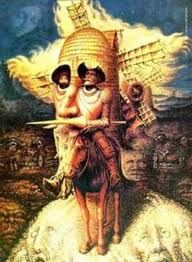Cross posted from The Stars Hollow Gazette
This is your morning Open Thread. Pour your favorite beverage and review the past and comment on the future.
Find the past “On This Day in History” here.
October 6 is the 279th day of the year (280th in leap years) in the Gregorian calendar. There are 86 days remaining until the end of the year.
On this day in 1927. The Jazz Singer makes its debut in New York City.
The first feature-length motion picture with synchronized dialogue sequences, its release heralded the commercial ascendance of the “talkies” and the decline of the silent film era. Produced by Warner Bros. with its Vitaphone sound-on-disc system, the movie stars Al Jolson, who performs six songs. Directed by Alan Crosland, it is based on a play by Samson Raphaelson.
The story begins with young Jakie Rabinowitz defying the traditions of his devout Jewish family by singing popular tunes in a beer hall. Punished by his father, a cantor, Jakie runs away from home. Some years later, now calling himself Jack Robin, he has become a talented jazz singer. He attempts to build a career as an entertainer, but his professional ambitions ultimately come into conflict with the demands of his home and heritage.
The premiere was set for October 6, 1927, at Warner Bros.’ flagship theater in New York City. The choice of date was pure show business-the following day was Yom Kippur, the Jewish holiday around which much of the movie’s plot revolves. The buildup to the premiere was tense. Besides Warner Bros.’ precarious financial position, the physical presentation of the film itself was remarkably complex:
Each of Jolson’s musical numbers was mounted on a separate reel with a separate accompanying sound disc. Even though the film was only eighty-nine minutes long…there were fifteen reels and fifteen discs to manage, and the projectionist had to be able to thread the film and cue up the Vitaphone records very quickly. The least stumble, hesitation, or human error would result in public and financial humiliation for the company.
None of the Warner brothers were able to attend: Sam Warner-among them, the strongest advocate for Vitaphone-had died the previous day of pneumonia, and the surviving brothers had returned to California for his funeral.
According to Doris Warner, who was in attendance, about halfway through the film she began to feel that something exceptional was taking place. Jolson’s “Wait a minute” line had prompted a loud, positive response from the audience. Applause followed each of his songs. Excitement built, and when Jolson and Eugenie Besserer began their dialogue scene, “the audience became hysterical.” After the show, the audience turned into a “milling, battling, mob”, in one journalist’s description, chanting “Jolson, Jolson, Jolson!” Among those who reviewed the film, the critic who foresaw most clearly what it presaged for the future of cinema was Life magazine’s Robert Sherwood. He described the spoken dialogue scene between Jolson and Besserer as “fraught with tremendous significance…. I for one suddenly realized that the end of the silent drama is in sight”.
Critical reaction was generally, though far from universally, positive. New York Times critic Mordaunt Hall, reviewing the film’s premiere, declared that
not since the first presentation of Vitaphone features, more than a year ago [i.e., Don Juan], has anything like the ovation been heard in a motion-picture theatre…. The Vitaphoned songs and some dialogue have been introduced most adroitly. This in itself is an ambitious move, for in the expression of song the Vitaphone vitalizes the production enormously. The dialogue is not so effective, for it does not always catch the nuances of speech or inflections of the voice so that one is not aware of the mechanical features.
Variety called it “[u]ndoubtedly the best thing Vitaphone has ever put on the screen…[with] abundant power and appeal.” Richard Watts, Jr. of the New York Herald Tribune called it a “a pleasantly sentimental orgy dealing with a struggle between religion and art…. [T]his is not essentially a motion picture, but rather a chance to capture for comparative immortality the sight and sound of a great performer.” The Exhibitors Herald’s take was virtually identical: “scarcely a motion picture. It should be more properly labeled an enlarged Vitaphone record of Al Jolson in half a dozen songs.” The film received favorable reviews in both the Jewish press and in African American newspapers such as the Baltimore Afro-American, the New York Amsterdam News, and the Pittsburgh Courier. The headline of the Los Angeles Times review told a somewhat different story: “‘Jazz Singer’ Scores a Hit-Vitaphone and Al Jolson Responsible, Picture Itself Second Rate.” Photoplay dismissed Jolson as “no movie actor. Without his Broadway reputation he wouldn’t rate as a minor player.”


 The Orient Express is the name of a long-distance passenger train, the route for which has changed considerably in modern times. The first run of The Orient Express was on 4 October 1883. The train travelled from Paris to Giurgiu in Romania, via Munich and Vienna. At Giurgiu, passengers were ferried across the Danube to Ruse in Bulgaria to pick up another train to Varna. From here they completed their journey to Istanbul by ferry.
The Orient Express is the name of a long-distance passenger train, the route for which has changed considerably in modern times. The first run of The Orient Express was on 4 October 1883. The train travelled from Paris to Giurgiu in Romania, via Munich and Vienna. At Giurgiu, passengers were ferried across the Danube to Ruse in Bulgaria to pick up another train to Varna. From here they completed their journey to Istanbul by ferry. In 1963, Bob Dylan was asked by the authors of a forthcoming book on Woody Guthrie to contribute a 25-word comment summarizing his thoughts on the man who had probably been his greatest formative influence. Dylan responded instead with a 194-line poem called
In 1963, Bob Dylan was asked by the authors of a forthcoming book on Woody Guthrie to contribute a 25-word comment summarizing his thoughts on the man who had probably been his greatest formative influence. Dylan responded instead with a 194-line poem called  The Twilight Zone is an American anthology television series created by
The Twilight Zone is an American anthology television series created by 








 Thomas Young was one of the first to attempt decipherment of the Egyptian hieroglyphs, basing his own work on the investigations of Swedish diplomat Akerblad, who built up a demotic alphabet of 29 letters (15 turned out to be correct) and translated all personal names and other words in the Demotic part of the Rosetta Stone in 1802. Akerblad however, wrongly believed that demotic was entirely phonetic or alphabetic. Young thought the same, and by 1814 he had completely translated the enchorial (which Champollion labeled Demotic as it is called today) text of the Rosetta Stone (he had a list with 86 demotic words). Young then studied the hieroglyphic alphabet and made some progress but failed to recognise that demotic and hieroglyphic texts were paraphrases and not simple translations. In 1823 he published an Account of the Recent Discoveries in Hieroglyphic Literature and Egyptian Antiquities. Some of Young’s conclusions appeared in the famous article Egypt he wrote for the 1818 edition of the Encyclopædia Britannica.
Thomas Young was one of the first to attempt decipherment of the Egyptian hieroglyphs, basing his own work on the investigations of Swedish diplomat Akerblad, who built up a demotic alphabet of 29 letters (15 turned out to be correct) and translated all personal names and other words in the Demotic part of the Rosetta Stone in 1802. Akerblad however, wrongly believed that demotic was entirely phonetic or alphabetic. Young thought the same, and by 1814 he had completely translated the enchorial (which Champollion labeled Demotic as it is called today) text of the Rosetta Stone (he had a list with 86 demotic words). Young then studied the hieroglyphic alphabet and made some progress but failed to recognise that demotic and hieroglyphic texts were paraphrases and not simple translations. In 1823 he published an Account of the Recent Discoveries in Hieroglyphic Literature and Egyptian Antiquities. Some of Young’s conclusions appeared in the famous article Egypt he wrote for the 1818 edition of the Encyclopædia Britannica.